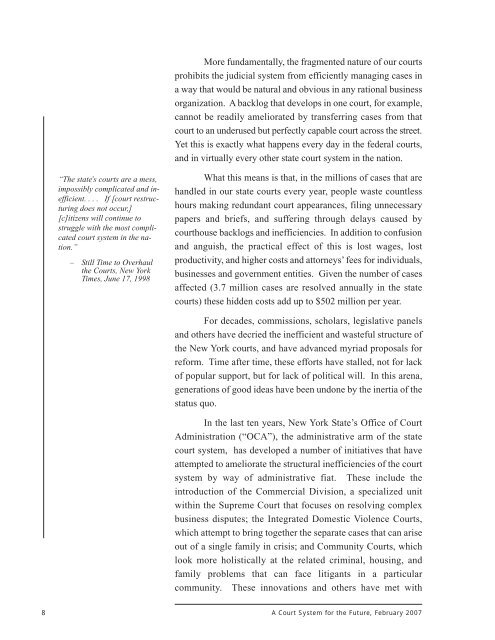Special Commission on the Future of the New York State Courts
Special Commission on the Future of the New York State Courts
Special Commission on the Future of the New York State Courts
Create successful ePaper yourself
Turn your PDF publications into a flip-book with our unique Google optimized e-Paper software.
More fundamentally, <strong>the</strong> fragmented nature <strong>of</strong> our courts<br />
prohibits <strong>the</strong> judicial system from efficiently managing cases in<br />
a way that would be natural and obvious in any rati<strong>on</strong>al business<br />
organizati<strong>on</strong>. A backlog that develops in <strong>on</strong>e court, for example,<br />
cannot be readily ameliorated by transferring cases from that<br />
court to an underused but perfectly capable court across <strong>the</strong> street.<br />
Yet this is exactly what happens every day in <strong>the</strong> federal courts,<br />
and in virtually every o<strong>the</strong>r state court system in <strong>the</strong> nati<strong>on</strong>.<br />
“The state’s courts are a mess,<br />
impossibly complicated and inefficient.<br />
. . . If [court restructuring<br />
does not occur,]<br />
[c]itizens will c<strong>on</strong>tinue to<br />
struggle with <strong>the</strong> most complicated<br />
court system in <strong>the</strong> nati<strong>on</strong>.”<br />
– Still Time to Overhaul<br />
<strong>the</strong> <strong>Courts</strong>, <strong>New</strong> <strong>York</strong><br />
Times, June 17, 1998<br />
What this means is that, in <strong>the</strong> milli<strong>on</strong>s <strong>of</strong> cases that are<br />
handled in our state courts every year, people waste countless<br />
hours making redundant court appearances, filing unnecessary<br />
papers and briefs, and suffering through delays caused by<br />
courthouse backlogs and inefficiencies. In additi<strong>on</strong> to c<strong>on</strong>fusi<strong>on</strong><br />
and anguish, <strong>the</strong> practical effect <strong>of</strong> this is lost wages, lost<br />
productivity, and higher costs and attorneys’ fees for individuals,<br />
businesses and government entities. Given <strong>the</strong> number <strong>of</strong> cases<br />
affected (3.7 milli<strong>on</strong> cases are resolved annually in <strong>the</strong> state<br />
courts) <strong>the</strong>se hidden costs add up to $502 milli<strong>on</strong> per year.<br />
For decades, commissi<strong>on</strong>s, scholars, legislative panels<br />
and o<strong>the</strong>rs have decried <strong>the</strong> inefficient and wasteful structure <strong>of</strong><br />
<strong>the</strong> <strong>New</strong> <strong>York</strong> courts, and have advanced myriad proposals for<br />
reform. Time after time, <strong>the</strong>se efforts have stalled, not for lack<br />
<strong>of</strong> popular support, but for lack <strong>of</strong> political will. In this arena,<br />
generati<strong>on</strong>s <strong>of</strong> good ideas have been und<strong>on</strong>e by <strong>the</strong> inertia <strong>of</strong> <strong>the</strong><br />
status quo.<br />
In <strong>the</strong> last ten years, <strong>New</strong> <strong>York</strong> <strong>State</strong>’s Office <strong>of</strong> Court<br />
Administrati<strong>on</strong> (“OCA”), <strong>the</strong> administrative arm <strong>of</strong> <strong>the</strong> state<br />
court system, has developed a number <strong>of</strong> initiatives that have<br />
attempted to ameliorate <strong>the</strong> structural inefficiencies <strong>of</strong> <strong>the</strong> court<br />
system by way <strong>of</strong> administrative fiat. These include <strong>the</strong><br />
introducti<strong>on</strong> <strong>of</strong> <strong>the</strong> Commercial Divisi<strong>on</strong>, a specialized unit<br />
within <strong>the</strong> Supreme Court that focuses <strong>on</strong> resolving complex<br />
business disputes; <strong>the</strong> Integrated Domestic Violence <strong>Courts</strong>,<br />
which attempt to bring toge<strong>the</strong>r <strong>the</strong> separate cases that can arise<br />
out <strong>of</strong> a single family in crisis; and Community <strong>Courts</strong>, which<br />
look more holistically at <strong>the</strong> related criminal, housing, and<br />
family problems that can face litigants in a particular<br />
community. These innovati<strong>on</strong>s and o<strong>the</strong>rs have met with<br />
8<br />
A Court System for <strong>the</strong> <strong>Future</strong>, February 2007
















